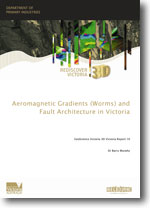3D Victoria Report 10 - Aeromagnetic gradients (worms) and fault architecture in Victoria
 |
| |||||
Product description:Summary This report presents aeromagnetic gradient data derived through an automated edge detection technique (“worms”), together with a representation of faults interpreted from the data. This follows on from a similar analysis of the Victorian gravity field (Fractore, 2009), and employs methodologies developed during the predictive mineral discovery CRC (pmd*CRC).An objective is to provide a more rigorous constraint on the positions and strengths of gradients, using CSIRO’s FracWormer and Intrepid’s WormE processes. From the 3D modelling perspective, important elements are depth and strike extensive boundaries (e.g. faults, fractures), and worm data can be particularly effective in areas where there is no surface geological expression. The GSV 1:1,000,000 scale geological coverage provides baseline information for the interpretation, which was undertaken at 1:500,000 scale. A high density of gradient data provides positional information on interpreted fault structures that have an associated susceptibility contrast. Other, more “enigmatic” faults, lacking a physical property contrast across them, can be inferred from truncations or offsets in adjacent gradients and through visual inspection of images. Many such fracture zones are interpreted (often not represented in the geological maps) which cross cut the major regional scale faults with little or no apparent offset, but can accommodate granites and other intrusive bodies. The interpretation tends to emphasise these elements through an evaluation of strike length. Strike and depth extensive boundaries are possible pathways for hydrothermal fluids. Images are derived as a form of prospectivity map where relative proximity to crustal scale faults may be an area selection factor. A combined strike length interpretation of data from the gravity, aeromagnetic and mapped faults is also derived which illustrates aspects of the state-wide fault architecture. Download The downloadable version of this report is supplied as a PDF file (2.9MB). Bibliographic reference Murphy, B., 2010. Aeromagnetic gradients (worms) and fault architecture in Victoria. GeoScience Victoria 3D Victoria Report 10. Department of Primary Industries. | ||||||

